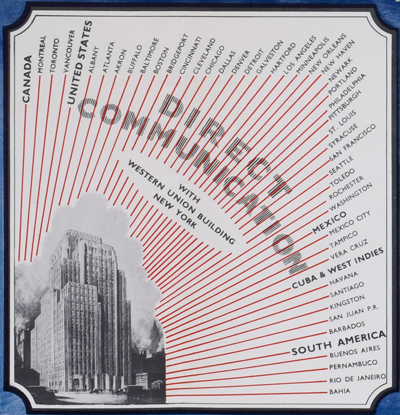DESCRIPTION: SOLD
Scarce thematic map of the world with Western Union's routes for underwater telegraphy cables (1) between Western Europe and the United States during the period between the wars. Dated circa 1930 based on the attention given to the Art-Deco style Western Union Building in N.Y.C. that was built in 1930. Sub-title notes Western Union key communications nodes between France, Holland, Germany, and Great Britain to New York, Boston, Washington, Montreal, and Toronto.
 Western Union Communications Network Nodes. 1930. Western Union Communications Network Nodes. 1930.
The main focus of the work is a 1930 snapshot of Western Union's wireless network (dashed red lines) and the cable network, shown (solid red lines) overlayed on a bathymetric chart with a bird's eye view of the ocean floor (if birds had x-ray vision). The bathymetric chart is surrounded with text and images relating to cable-laying ships including the Great Eastern (2).
By 1861 the Western Union Telegraph Company completed the first transcontinental telegraph line, which enabled communication between the East and West coasts of the United States in a matter of minutes.
During the 1920s, Western Union expanded its services by launching the first commercial microwave communications system and investing in radio broadcasting. The Great Depression severely impacted the company and as a result, Western Union filed for bankruptcy in 1933 and underwent reorganization under new management.
(1) About 1930 the length of all undersea transatlantic cables laid was approximately 60,000 miles. At that time, these cables were primarily used for telegraph communication, as telephone technology was still in its early stages. The cables were laid by various companies, including Western Union and the British Cable and Wireless company.
(2) At her launch in 1857 the Great Eastern was the single heaviest object moved by humans until then. Designed as a passenger liner the Great Eastern was converted for transatlantic underwater cable laying. She was chosen to lay the first transatlantic telegraph cable due to her size, strength, and three power sources: a single screw propellor, two paddle wheels, and auxiliary sail power. The first attempt failed but in in 1866 succeeded thanks to improvements in cable technology and cable-laying techniques. The Great Eastern went on to lay cables across the Mediterranean, Indian Ocean, and other locations globally.
PUBLICATION DATE: 1930
GEOGRAPHIC AREA: World
BODY OF WATER: All
CONDITION: Good.
Minor wear at folds and edges. Strong color. Folds as issued.
COLORING: Lithographed color.
ENGRAVER:
SIZE: 33
" x
21 "
ITEM PHYSICAL LOCATION: 150
PRICE: $
ADD TO CART

|